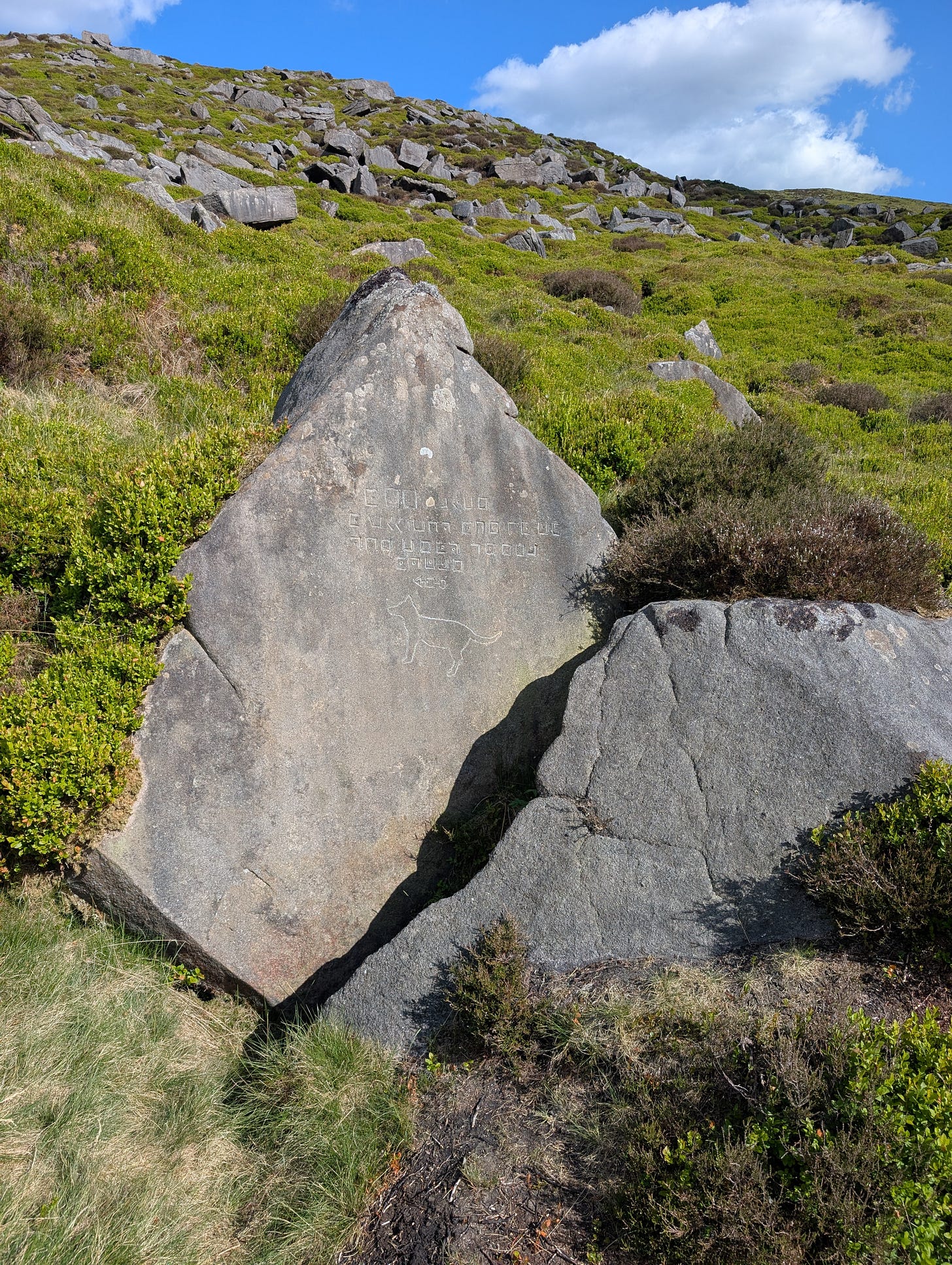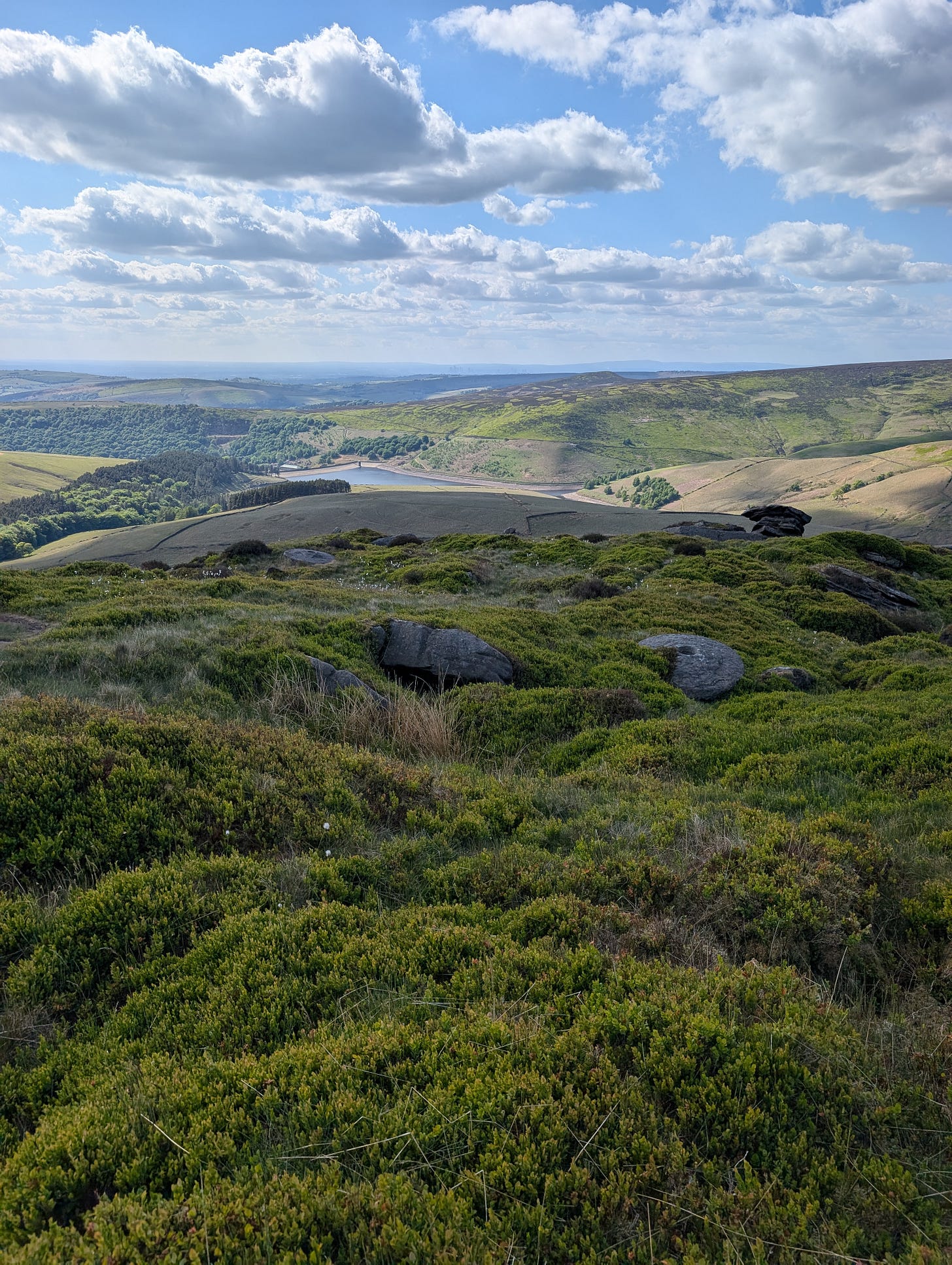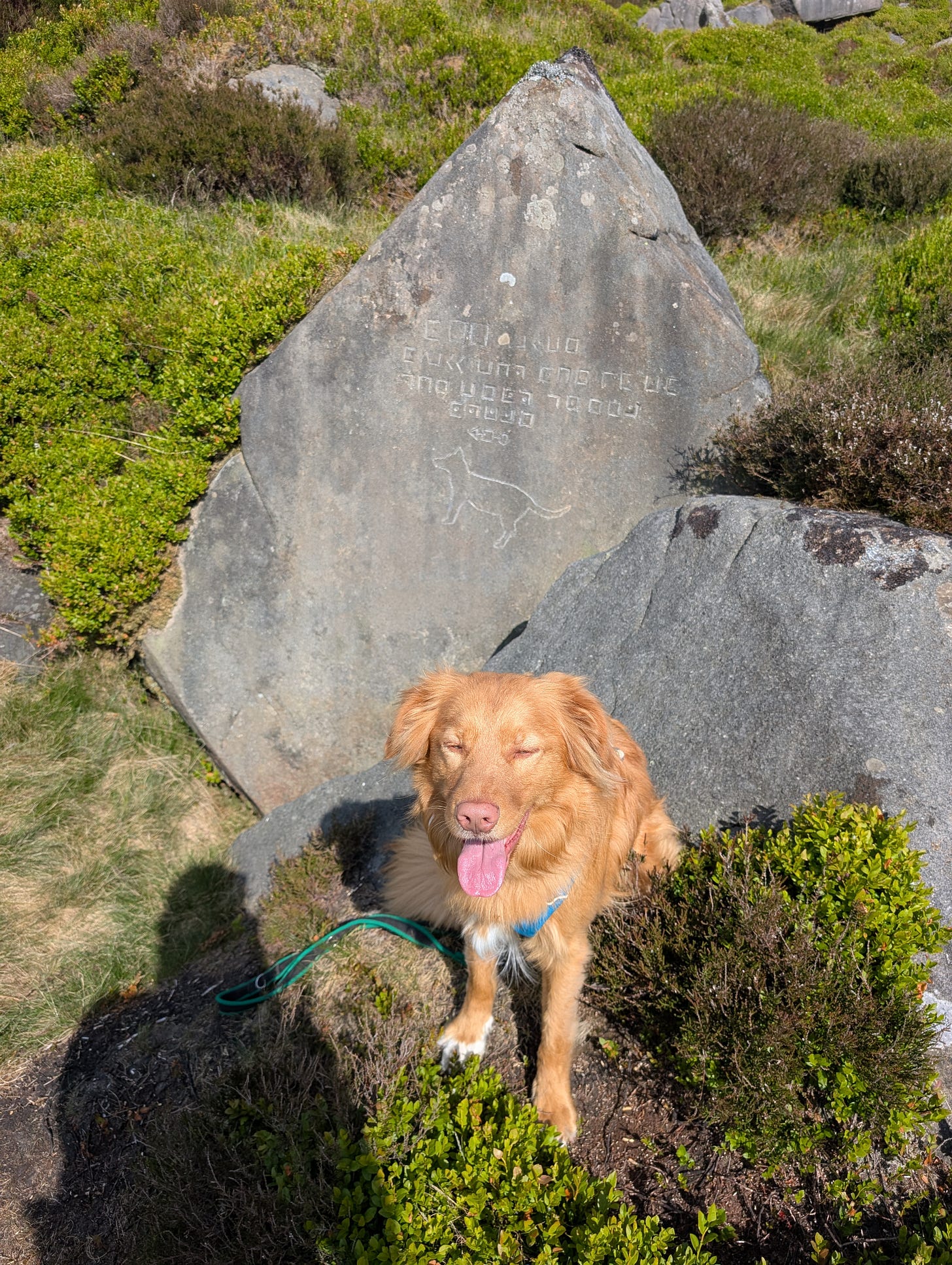The Curious Incident of the Dog in Kinder's Quarried Stone
Signs on Kinder Scout’s Dog Stone hark tales of freemasons, folklore, and four-legged friends.
Kinder is a landscape abounding with folklore and mystery. Cavers pore over debates on the lost entrance to the fabled Kinderlow Cavern. Tales of mermaids, nymphs, and ancient Celtic rituals are tied to Kinder’s eerie Mermaid Pool. Lost hikers caught in adverse weather report being guided to safety by the ghosts of those who perished in plane crashes around the plateau.
I was searching for one Kinder legend on my hike: the enigmatic Dog Stone.
Mentioned to me by a fellow hiker whose enthusiasm for history and folklore matched my own, the Dog Stone doesn’t appear on any maps. You won’t find it in any guidebooks. Few trail planning apps mention it. It's one of those whispered-about features, shared between hikers over pints and storm shelters.
I’d started my day with gusto and a sense of adventure alongside Tryfan the Toller. What he lacks in navigational talent he compensates for by bounding through any wild terrain and stealing bananas from unsuspecting hikers’ lunches. Several hours in — half-lunging, part-falling through the notorious concealed ankle-breaker holes among Cluther Rocks — I was questioning my sanity.
Tryfan was in his element, bounding across the boulder fields and resting astride a domed quern stone. These much-needed beacons were the confirmation among the jagged gibbers that we were on the right track.
Humankind’s connection to Kinder’s wild terrain stretches back a millennia. Archaeologists have uncovered Bronze Age flint tools and arrowheads along its slopes. The area is mentioned in both the Domesday Book1 and the Rotuli Hundredorum, and the famous Downfall waterfall is referred to in the latter as "Cliff of the Beacon Fires”.
Prehistoric burial mounds dot the hillsides. Medieval earthworks squiggle Kinder’s sides like ancient fingerprints. Its western reaches, including Cluther Rocks, have long been a source of quality stone. Lichen and bilberry gradually reclaim these echoes of industry but among the worked remnants, I finally stumbled across the Dog Stone.

It stood below my head height, partially sheltered by low shrubs, gazing east across Kinder Reservoir to the gentle slopes of Leygatehead Moor. Its smooth surface sparkled in the light, giving the mysterious carvings on its upper side an almost supernatural sheen.
The incisions of the symbols are clean, measured and precise. The carvings look as if they were done yesterday.
The figure resembled a working hound, with a strong jaw, muscular hind legs, stocky midriff and pointed, alert ears. Even the flick of the dog’s narrow tail appeared animated and alive. Around it sits three lines of symbols: dots, dashes, and lines. At the bottom three symbols jump out, drawn in a slightly different style to the rest.
There’s no author’s signature. No graffiti to suggest who left the message, or why this location was chosen.
Like other hikers before me, I leave the Dog Stone with more questions than answers and a hunger to learn more.
Back home, I began digging into the archaeology of the area. According to The National Trust Heritage Records2 Cluther Rocks is rich in evidence of millstone and grindstone quarrying, dating from the Iron Age and Roman periods through to the 18th century. Evidently the stone here is of exceptional quality.
One record in particular stands out:
“On one boulder within the area of quarrying in Cluther Rocks is an inscription in code accompanied by an arrow pointing east and the depiction of a dog. The code is reputedly that of the Freemason's and has been translated by Brian Robinson as follows:
SHE MAY BE
SMALL BUT SHE IS OF
THE BEST GREEN
STONE
The arrow also has the symbol for E (east) inscribed in its centre. There is no indication of when this might have been carved.”
The mention of Freemasons sparked my interest. Freemason’s Code is a common synonym for Pigpen Cypher. Effectively, it’s a coded system that substitutes geometric shapes for letters. While Pigpen Cypher’s stretch to the 1500s, the version Freemasons popularised is a later version with dots and squares.
On the map, the Dog Stone lies in a stretch of lush green moorland, pockmarked by quality gritstone. Whoever carved the message likely knew the land well.
Perhaps the inscription was the work of a quarryman who was also a Freemason? Lamenting the loss of a beloved terrier that accompanied him to work, he etched a tribute to him, comparing the dog’s loyalty and strength to the prized stone they worked together. The arrow might mark a final resting place, pointing toward the hills the pair once roamed, or his companion’s final resting place?
It’s a common theory among hikers, but has its challengers. In his blog post recreating the Dog Stone Stu Wakefield from Ranger Expeditions points out that the first word of the cipher, often read as “she,” could in fact be “see,” changing the tone of the inscription entirely.
Stu’s post explores the possibility that the final line of code is more Masonic symbology. It could refer to the standard Masonic badge of the square and the circle, symbolising the convergence of earthly and spiritual responsibilities.
He also posits that the geometric shapes hold more general symbolism in Western society. In particular:
Triangle: past, present, and future
Square: stability, the earth
Circle: spirituality, wholeness, the sacred found in nature
In Stu’s opinion, the Dog Stone carving is a tribute of gratitude to God, the landscape, and the living things that call it home, and the interconnectivity between the three.
Without further archaeological research or knowledge of the artist’s identity, the Dog Stone’s meaning is up to interpretation. At the heart of the discussion though, does it matter?
If the artist wanted their intention truly known, they would have elucidated.
As for me? After a day hiking in the sunshine around Kinder with Tryfan trotting by my side, I couldn’t help but feel a deep sense of gratitude for the landscape, the legends, and the quiet companionship of a loyal friend.
If you ask Tryfan, I reckon he’d say it was a monument to canine superiority. But he’s too busy munching on the banana he took from my bag to confirm.
What’s your interpretation of the Dog Stone?
Powell-Smith, A. (2025). Kinder | Domesday Book. [online] Opendomesday.org. Available at: https://opendomesday.org/place/SK0687/kinder/ [Accessed 30 May 2025].
Bevan, B. (1999). https://nationaltrusthbsmr.esdm.co.uk/LLWS/LLFiles/154818/original_154818.pdf. [online] National Trust Heritage Records. Available at: https://nationaltrusthbsmr.esdm.co.uk/LLWS/LLFiles/154818/original_154818.pdf [Accessed 30 May 2025].












Tryfan is adorable. He can have all the bananas. ❤️ 🐕